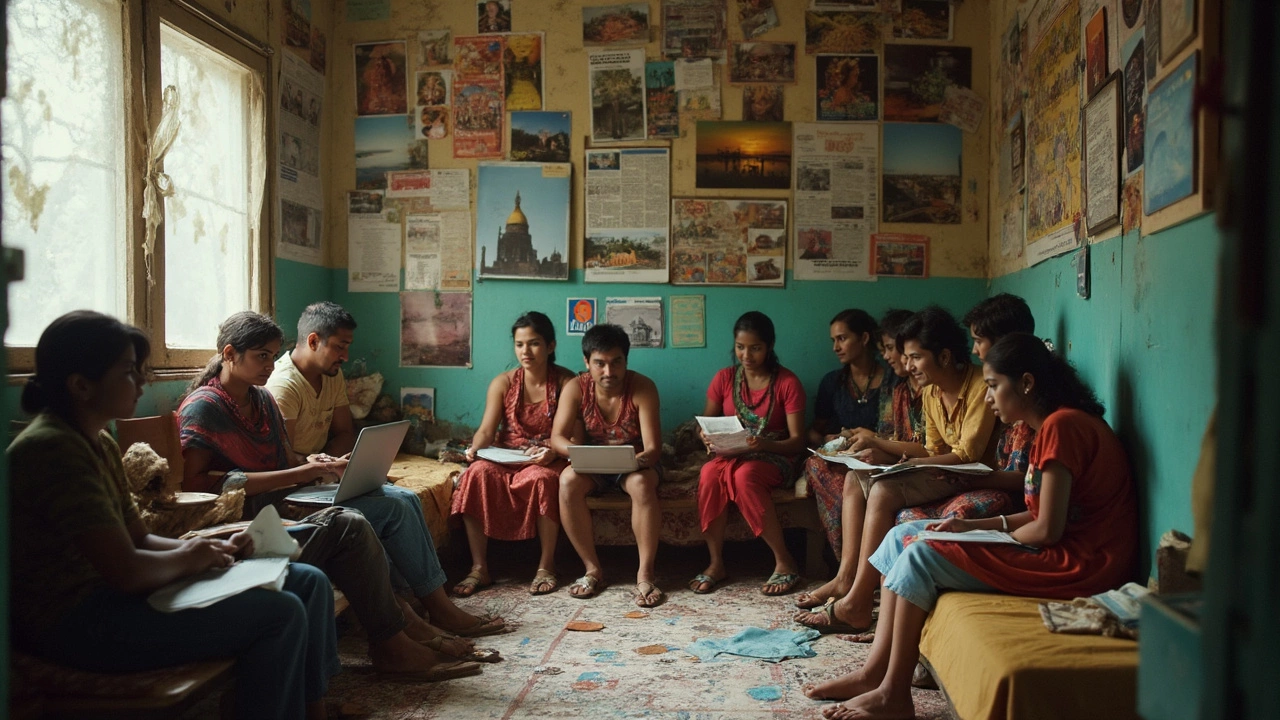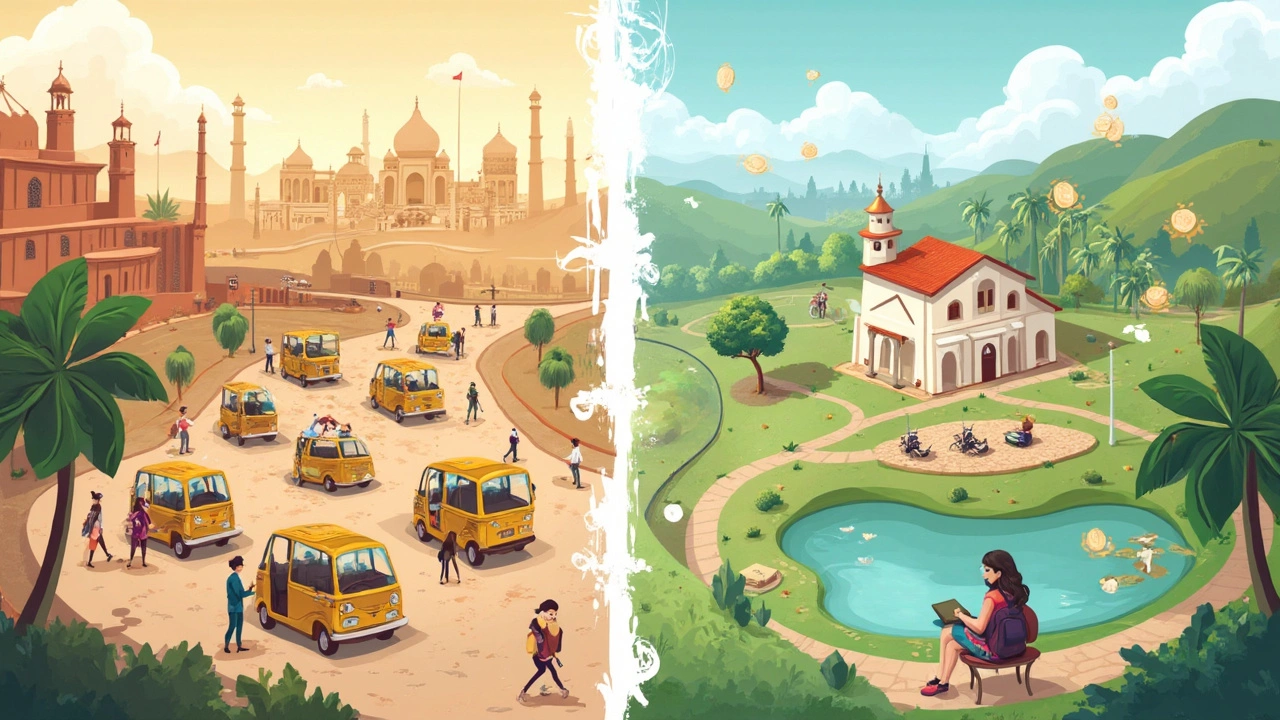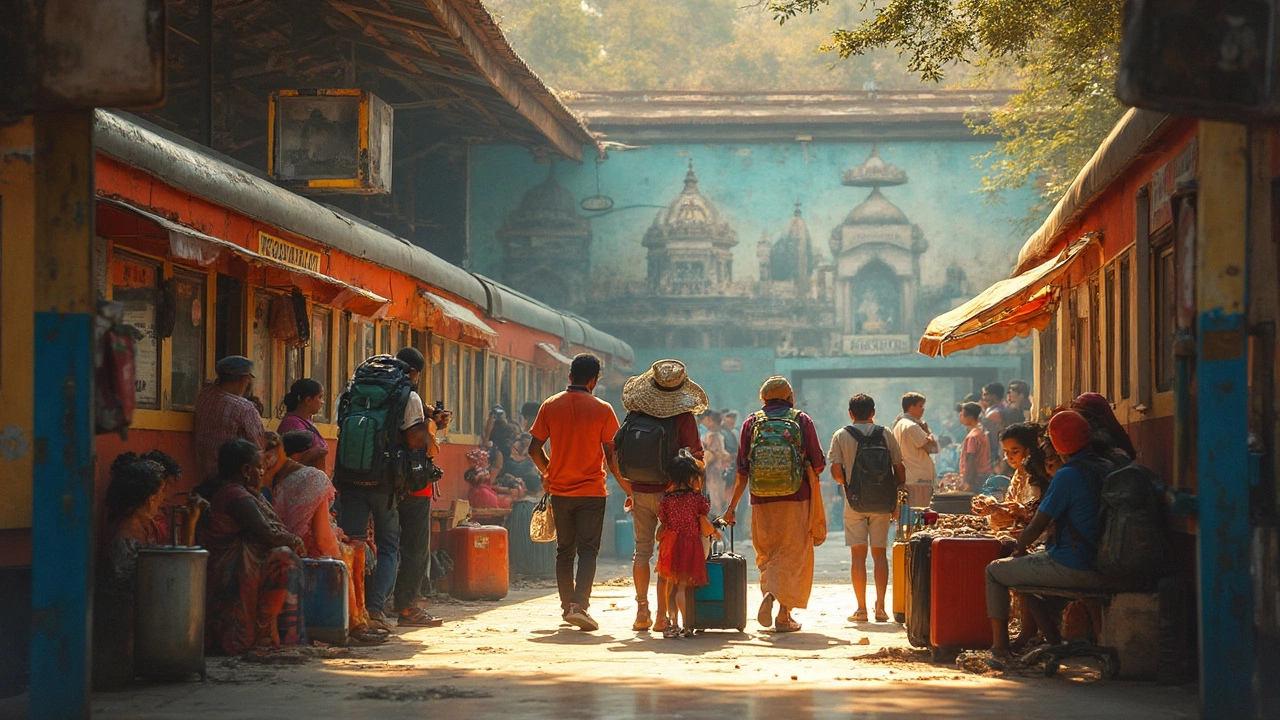Picturing India for the first time? It’s wild, huge, and packed with more sights than you could ever hope to see in one go. But here’s the real question—how many days do you actually need to get a good feel for the place, without burning through your bank account or patience?
If you’re thinking you can "do India" in a week, brace yourself. The trains run late, the distances are no joke, and every city feels like its own universe. Still, that doesn't mean you need months, either. With a smart plan and some honest expectations, even a week or ten days can cover more ground than you’d expect—especially if you keep things tight and pick a region, not the whole country.
The secret sauce? Travel slow, focus on what you really care about, and skip the mad-dash cross-country zigzag. If you just want postcard shots of the Taj Mahal and a few markets, a week will do. But if you want to eat street food in Delhi, wander Rajasthan’s forts, and chill by the Ganges in Varanasi, you’ll need closer to two weeks—or three, if you can swing it for less rushed vibes.
- How Long Do Most People Spend in India?
- What Can You Do in 7, 10, or 14 Days?
- Stretching Your Budget: Smart Planning Hacks
- Mistakes Travelers Make When Gauging Time
- Must-Know Tips for Making the Most of Your Stay
How Long Do Most People Spend in India?
If you ask most travelers, the answer to “how long is enough in India?” usually lands somewhere between one and three weeks. For a lot of India travel days planners, the magic number seems to fall around the two-week mark. That’s long enough to get a solid taste of a couple of regions, but not so long that you’ll run out of energy (or laundry).
Here’s the interesting part: according to the Ministry of Tourism India, overseas tourists averaged about 15 days per trip in 2023 — and that’s not counting domestic travelers, who often do shorter, focused trips. Those on long sabbaticals or gap years might stick around for months, but if you look at budget or first-time travelers, it’s almost always a 10- to 16-day sweet spot.
| Trip Length | Percentage of Travelers |
|---|---|
| Up to 7 days | 19% |
| 8 - 14 days | 44% |
| 15 - 21 days | 26% |
| Over 21 days | 11% |
Why do most stick to this itinerary planning? Well, India packs a punch—a sensory overload, with distances that surprise most people. Squeezing in too much leads to burnout, and nobody comes to India hoping to spend their budget stress-sleeping on night trains.
Travel guru Lonely Planet puts it best:
"India isn’t a country you see in one trip. Every journey there leaves you wanting to come back for the pieces you missed."
If you’re on a budget India mission, you’ll notice that stretching past two weeks only saves money if you slow down. Fast travel means more spent on transport and logistics. Long stays can actually lower your daily spend if you stick to local eats and use trains or buses over flights. That’s how the seasoned backpackers pull off month-long trips without going broke.
So, bottom line: most travelers spend 10 to 16 days and leave itching for more. It’s enough time for highlights, lessons in patience, and maybe, just maybe, planning your next trip back.
What Can You Do in 7, 10, or 14 Days?
No matter how many days you lock in, smart planning is key for India travel days on a budget. Here’s what folks usually pull off in 7, 10, or 14 days—without losing their mind or their wallet.
With 7 Days: Stick to a single region. The Golden Triangle—Delhi, Agra, Jaipur—is the classic budget route. In a week, you can:
- Marvel at the Taj Mahal at sunrise (Agra)
- Explore the chaos and street food in Old Delhi
- Check out Jaipur’s forts, markets, and pink old city
The triangle can be done with cheap trains or public buses, and you'll spend less time and cash just getting between sights.
10 Days: Now you’ve got options. With 10 days, you might add Varanasi for spiritual river scenes or head west to Udaipur—famous for its lakes and laid-back feel. Another solid move? Pick Kerala in the south for backwaters, beaches, and hill stations like Munnar. Domestic flights in India are cheap if you book ahead, making longer jumps doable.
- Golden Triangle plus Varanasi or Udaipur, or
- Cochin – Munnar – Alleppey (houseboat) – Varkala beach (Kerala route)
14 Days: Two weeks brings breathing room. Now, slower travel means less time rushing and more time soaking it in. Add a mountain side-trip, say to Rishikesh or Dharamshala, if you’re interested in yoga or hiking. Or combine north and south—Golden Triangle plus Kerala—if you’re okay with a fast-paced trip and a couple cheap domestic flights.
Here’s a quick look at what these sample itineraries might cost you on a tight budget:
| Duration | Typical Budget (INR) | Main Regions Visited |
|---|---|---|
| 7 days | 12,000-18,000 | Golden Triangle (Delhi, Agra, Jaipur) |
| 10 days | 18,000-28,000 | Triangle + Varanasi/Udaipur or Kerala |
| 14 days | 28,000-40,000 | North + South combo, or slow travel in Rajasthan/Kerala |
Core costs cover cheap guesthouses, trains or buses (with maybe a sleeper class overnight thrown in), daily meals, and basic entry fees. If you splurge on AC trains or fancy meals, add a few thousand more.
Whatever length you choose, the trick is not to cram too many places in. Each city takes time to get around, and you’ll lose hours (sometimes full days) moving between them. In India, less really is more. Pick a theme or a top region and give yourself time to actually enjoy it. That’s what makes a budget India trip unforgettable, not just a blurry checklist.

Stretching Your Budget: Smart Planning Hacks
India can be dirt cheap or sneakily expensive, depending on how you plan. If you're watching your wallet and maximizing your budget India trip, you gotta be smart from the start. Here’s how to keep your bank balance—and sanity—in check while still soaking up the best of the country.
- Book trains early: Train tickets in India are a steal, but the good seats go fast. For long overnight rides—think Delhi to Varanasi—book at least a month out if you can. Last-minute tickets (Tatkal) open up the day before you travel, but you’ll pay more and it’s a gamble whether you’ll get a spot.
- Use budget airlines for big jumps: India is huge. Instead of spending 24 hours on a train from Mumbai to Kolkata, low-cost carriers like IndiGo and SpiceJet can save you heaps of time and energy. Book in advance and it’s often no more expensive than the priciest trains, especially when you factor in saving a day or two off your India travel days.
- Eats and stays: Street food is not only tasty but usually safer than you think—as long as it’s busy and fresh. You can eat from dhabas (roadside shacks) for under $2 per meal. Hostels and guesthouses are everywhere, with dorm beds in tourist areas like Jaipur and Rishikesh starting from $5. Don’t ignore OYO rooms—they’re basic but reliable for private stays on a budget.
- Plan by region, not country: Don’t try to hit Kerala’s beaches and the Himalayas on the same trip. Pick one corner—like Rajasthan or the south—so you spend less on travel and more on experiences. Regional travel passes and local buses are way cheaper than cross-country treks.
- Go with free or nearly-free stuff: City walking tours (especially in Delhi and Mumbai) are often free, tip-based, or super cheap. Most temples don’t charge entry fees. Markets, festivals, and local parks offer a peek into daily life for no cost.
Check these rough daily cost ideas (in USD, as of late 2024):
| Item | Low Budget | Mid Budget |
|---|---|---|
| Accommodation | $5-10 | $20-30 |
| Food | $2-5 | $10-15 |
| City Transport | $1 | $5 |
| Intercity Transport | $5-15 | $25-40 |
| Typical Total/Day | $10-30 | $50-90 |
Bottom line? Not every corner has to cost you precious rupees. Skip pricey tours, watch out for tourist traps, and always ask locals for what they’d pay. Your budget will last longer, and you’ll get a better story out of it.
Mistakes Travelers Make When Gauging Time
One of the classic mistakes new visitors make when planning India travel days is letting Google Maps set your expectations. India looks close on a map, but reality hits hard once you jump on an overnight train that takes 14 hours to crawl from Delhi to Varanasi. Even domestic flights eat up time with unpredictable delays and crowded airports. If you think you’ll breeze between four different states in a week, you’re setting yourself up for disappointment.
Another misstep? Jamming too many places into a single itinerary planning session. Travelers often try to tick off Delhi, Agra, Jaipur, Varanasi, and Goa in ten days. That’s technically possible, but mostly you’ll see the inside of taxis, trains, and bus stations—missing the actual vibe of each place.
Here’s what seasoned travel journalist Shivya Nath said in an interview with Lonely Planet:
“Most first-timers underestimate how long everything takes in India. The best memories come when you slow down and let India surprise you, not when you’re glued to a tight timeline.”
Folks also forget to factor in downtime, jet lag, or days where food doesn’t agree with your stomach. Trust me, that’s more common than you think, especially if you’re hitting the street food stalls. And let’s not ignore the festival season—holy smokes, travel times can double during events like Diwali or Holi, with trains and guesthouses booked out weeks ahead.
- Overlooking travel time between cities—expect 8-15 hours between big destinations.
- Underestimating crowds at major sights. Taj Mahal at sunrise? Get ready to queue.
- Skipping buffer days for rest, sudden illness, or transport hiccups.
- Not realizing how draining the heat and humidity can be, especially from April to June.
Here’s a quick look at how much actually gets eaten up by travel itself:
| Trip Segment | Typical Time Needed |
|---|---|
| Delhi to Jaipur (by train) | 4-6 hours |
| Delhi to Varanasi (by train) | 12-14 hours |
| Agra to Goa (flight + transfer) | 6-9 hours (door to door) |
Aim to focus your budget India trip on a few key places rather than pretending you’ll cover more ground than you actually can. Slow travel means less stress, more time for weird little detours, and space for travel mishaps—because they’re guaranteed to happen at least once.

Must-Know Tips for Making the Most of Your Stay
First up: Don’t even try to "see it all"—that’ll only lead to frustration and crazy travel days. Focus your India travel days on one region, so you cut down on exhausting overnight train journeys or flight headaches. Places like Rajasthan or Kerala have so much jammed close together, you won’t feel like you’re missing out.
Next, timing is everything. India’s not just one big weather zone, so double-check where you’re going and when. North India in late spring? Prepare for 40°C heat. Down south in monsoon? Pack rain gear and keep your itinerary flexible. If you aim for February to April, you’ll usually get a sweet spot—less rain, not boiling hot, and not crazy crowded.
For budget India travel, trains and sleeper buses are your best buddies. Indian Railways can get complicated, though: book tickets in advance online (IRCTC or trusted apps), especially if you want to lock in those cheap sleeper or AC class fares. Watch out for "Tatkal" tickets—they’re last-minute and cost more.
- Eat local. Skip tourist cafes and hit up street food spots or busy dhabas where locals go. Not only is it way cheaper, but honestly, the food’s better. A thali meal can cost under $2 and fill you up for hours.
- Stay connected. A local SIM card (Airtel or Jio are popular) helps with maps, bookings, and even bargaining. You need your passport and a quick photo for registration—some airports and big stations have official booths.
- Bring copies of important docs: hotels randomly ask for your passport, and train stations might want printouts of your ticket.
- If you’re the type to try everything, remember Delhi belly is real. Stick to cooked foods, bottled water (check the seal), and wash your hands constantly.
Here’s a look at how your cash might shake out. Even on the cheap, India can really stretch your money:
| Expense | Average Budget (per day) |
|---|---|
| Hostel/Guesthouse | $7-15 |
| Street Food/Local Meals | $3-6 |
| Trains/Buses | $2-8 |
| Entry Fees (sites, museums) | $2-5 |
Keep track of your costs so you don’t get caught out. Most folks end up spending less than $25-30 a day if they stick to basics. That means you can stretch your itinerary planning to fit your wallet, even if you decide to add an extra city or stay longer somewhere you love.
The final bit: never underestimate travel times. Look up distances on Google Maps, then add at least 20%-30% for delays, especially on trains. That way you don’t miss the big stuff by banking on tight connections or perfect arrivals.
